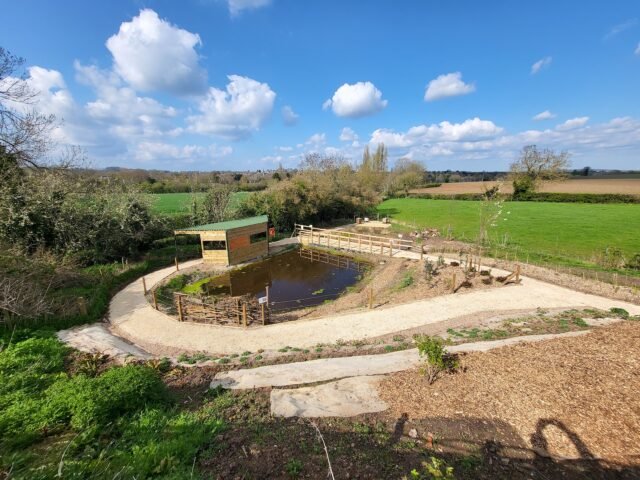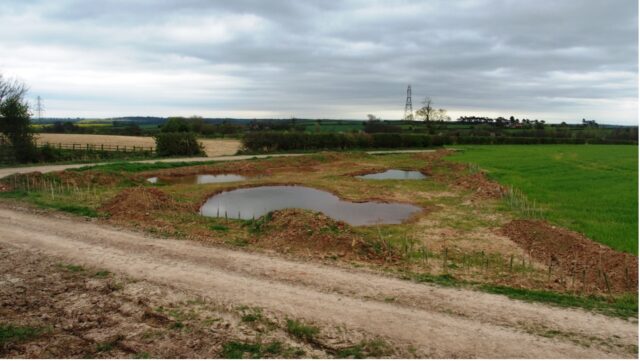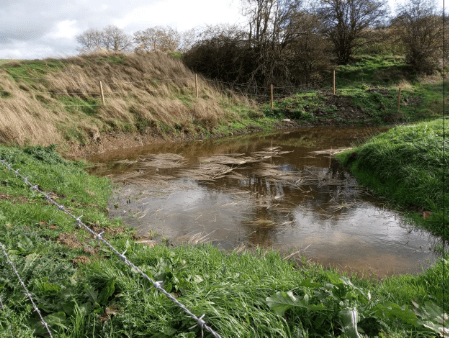
Ponds are enchanting features that can significantly enhance the biodiversity of any landscape. By designing and maintaining a pond with wildlife in mind, you can create a thriving ecosystem that supports a wide range of species, from aquatic plants and insects to amphibians, birds, and mammals.
Here at EMEC our land management team undertakes a wide range of pond and wetland habitat creation schemes on behalf of clients.
If you are considering adding a pond as part of your upcoming project, our land management team has drafted the below article to provide you with essential guidelines to create a wildlife-friendly pond that benefits and attracts various forms of life.
Designing your pond
Wildlife ponds created by EMEC can be anywhere between 100m2 to 1000m2 in size, with a variety of depths, to create a varied habitat which will accommodate a variety of flora and fauna. Shallows that hold marginal and marsh vegetation and allows amphibians such as newts and other invertebrates to lay eggs. With deeper sections for submerged vegetation with the deepest section allowing evaporation to occur yet retaining water. Complete drying of ponds is acceptable occasionally. This controls any species such as fish and invasive plants that could cause an unbalance in the native ecosystem of the pond.
The pond should be located away from trees whose falling leaves could cause water quality issues. Avoid places where runoff from roads or agricultural areas may contaminate the water.
The bigger the pond, the more diverse the ecosystem. When designing, it is best to make the edges slightly irregular, as this will create a more interesting shape and add more edges (habitat) to the pond, which increases its value to wildlife and gives them more options.
Using native plants for your pond
For wildlife to thrive, ideally ponds will populate naturally. To achieve this quickly EMEC can also create planting schemes using native aquatic plants, as they are adapted to the local environment and provide better habitat and food sources for local wildlife. Include submerged plants, floating plants, and emergent plants around the edges. These plants provide shelter, nesting sites, and food for insects and other small animals.
Invasive species can quickly take over a pond, outcompeting native species and disrupting the natural balance of the ecosystem. Adding in rocks, logs, and aquatic vegetation both in and around the pond will create a natural habitat for various species. Amphibians and small fish will use these features to hide from predators.
How to build a wildlife friendly pond
A natural unlined pond is preferable but not always achievable as you need to have a heavy clay soil.
Alternatively, a pond liner, which will hold in the water and function as a sealant is used. Various pond liners can be used, such as bentonite, PVC, rubber, wool or clay lined.
How does EMEC help clients create ponds and wetland areas?
Our role as the environmental consultant is as much about protecting habitats as it is about offering advice to our clients so that the communities they create, do incorporate biodiversity.
We collaborate with clients to ensure they incorporate ponds within the design plans of their development schemes. The key to a successful wildlife pond lies in thoughtful design, native plant species selection, and responsible maintenance.
Our staff have experience of creating ponds for great crested newt mitigation, creation of wet scrapes for breeding waders and restoration of wetland habitats to benefit a wide range of species including invertebrates and water vole.
EMEC is also one of a select number of ecology consultants appointed as a delivery partner for Natural England to create or restore much needed ponds to provide habitat for great crested newts (GCN) as part of a scheme called District Level Licensing (DLL). We work with local landowners, councils and Wildlife Trusts to identify potential sites within Strategic Opportunity Areas (SOA) throughout Leicestershire, Rutland, Rushcliffe, South Kesteven and Nottinghamshire.
By creating wildlife-friendly ponds, we help clients contribute to local biodiversity conservation.
If you have an upcoming development that requires specialist ecology, biodiversity, land management or arboriculture expertise, please do not hesitate to get in touch.



